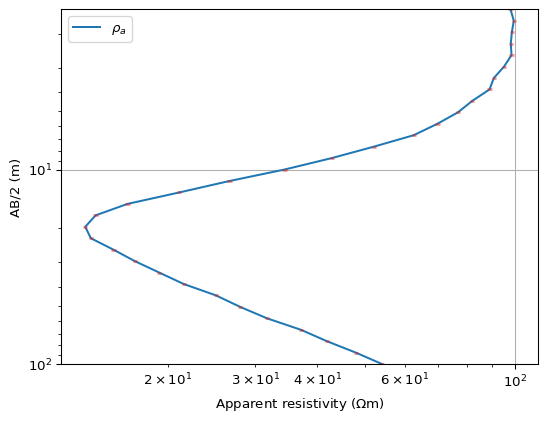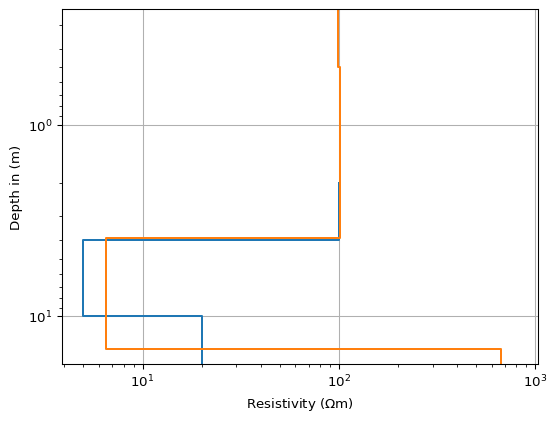pygimli.physics.ves#
Vertical Electric Sounding (VES).
Tools, modelling operators, and managers for VES.
Main class:
VESManager - Manager for loading, inverting & plotting
Modelling operators:
VESModelling - DC modelling operator using block model
VESRhoModelling - DC modelling operator
VESCModelling - DC/IP (complex-valued) modelling
Overview#
Functions
|
Synthetic forward simulation. |
Classes
alias of |
|
|
Vertical Electrical Sounding (VES) complex forward operator. |
|
Vertical electrical sounding (VES) manager class. |
|
Vertical Electrical Sounding (VES) forward operator. |
|
Vertical electrical sounding (VES) modelling with fixed layers. |
Functions#
- pygimli.physics.ves.simulate(res, thk=None, **kwargs)[source]#
Synthetic forward simulation.
- Parameters:
res (array-like) – resistivity vector or thicknesses+resistivities
thk (array-like) – thickness vector (if not, taken from res entries) geometry definition
ab2 (array-like) – Half distance between the current electrodes A and B.
mn2 (array-like) – Half distance between the potential electrodes M and N. OR
am (array-like) – Part of data basis. Distances between A and M electrodes.
bm (array-like) – Part of data basis. Distances between B and M electrodes.
an (array-like) – Part of data basis. Distances between A and N electrodes.
bn (array-like) – Part of data basis. Distances between B and N electrodes. OR
data (pg.DataContainerERT) – pyGIMLi data container from which AM/AN/BM,BN are taken
Classes#
- pygimli.physics.ves.Manager#
alias of
VESManager
- class pygimli.physics.ves.VESCModelling(**kwargs)[source]#
Bases:
VESModellingVertical Electrical Sounding (VES) complex forward operator.
Vertical Electrical Sounding (VES) forward operator for complex resistivity values. see:
pygimli.physics.ert.VESModelling- drawData(ax, data, error=None, labels=None, ab2=None, mn2=None, **kwargs)[source]#
Draw modeled apparent resistivity and apparent phase data.
- Parameters:
ax (axes) – Matplotlib axes object to draw into.
data (iterable) – Apparent resistivity values to draw. [rhoa phia].
error (iterable [None]) – Rhoa in Ohm m and phia in radiand. Adds an error bar if you have error values. [err_rhoas err_phia] The error of amplitudes are assumed to be relative and the error of the phases is assumed to be absolute in mrad.
labels (str [r'$varrho_a$', r'$varphi_a$']) – Set legend labels for amplitude and phase.
ab2 (iterable) – Override ab2 that fits data size.
mn2 (iterable) – Override mn2 that fits data size.
plot (function name) – Matplotlib plot function, e.g., plot, loglog, semilogx or semilogy
- class pygimli.physics.ves.VESManager(**kwargs)[source]#
Bases:
MethodManager1dVertical electrical sounding (VES) manager class.
Examples
>>> import numpy as np >>> import pygimli as pg >>> from pygimli.physics import VESManager >>> >>> ab2 = np.logspace(np.log10(1.5), np.log10(100), 32) >>> mn2 = 1.0 >>> # 3 layer with 100, 500 and 20 Ohmm >>> # and layer thickness of 4, 6, 10 m >>> # over a half-space of 800 Ohmm >>> synthModel = pg.cat([4., 6., 10.], [100., 5., 20., 800.]) >>> ves = VESManager() >>> ra, err = ves.simulate(synthModel, ab2=ab2, mn2=mn2, noiseLevel=0.01) >>> ax = ves.showData(ra, error=err) >>> model = ves.invert(ra, err, nLayers=4, showProgress=0, verbose=0) >>> ax, _ = ves.showModel(synthModel) >>> _ = ves.showResult(ax=ax)


- __init__(**kwargs)[source]#
Initialize instance.
- Keyword Arguments:
**kwargs –
- complex: bool
Accept complex resistivities.
- property complex#
Return whether the computations are complex.
- createForwardOperator(**kwargs)[source]#
Create Forward Operator.
Create Forward Operator based on complex attribute.
- invert(data=None, err=None, ab2=None, mn2=None, **kwargs)[source]#
Invert measured data.
- Parameters:
data (iterable) – data vector
err (iterable) – error vector
ab2 (iterable) – AB/2 vector (otherwise taken from data)
mn2 (iterable) – MN/2 vector (otherwise taken from data)
- Keyword Arguments:
**kwargs – Additional kwargs inherited from %(MethodManager1d.invert) and %(Inversion.run)
- Returns:
model – inversion result
- Return type:
pg.Vector
- class pygimli.physics.ves.VESModelling(ab2=None, mn2=None, **kwargs)[source]#
Bases:
Block1DModellingVertical Electrical Sounding (VES) forward operator.
- Parameters:
ab2 (array-like) – Half distance between the current electrodes A and B.
mn2 (array-like) – Half distance between the potential electrodes M and N. Only used for input (feeding am etc.) or plotting.
am (array-like) – Part of data basis. Distances between A and M electrodes. A is first current, M is first potential electrode.
bm (array-like) – Part of data basis. Distances between B and M electrodes. B is second current, M is first potential electrode.
an (array-like) – Part of data basis. Distances between A and N electrodes. A is first current, N is second potential electrode.
bn (array-like) – Part of data basis. Distances between B and N electrodes. B is second current, N is second potential electrode.
nLayers (int [4]) – number of layers, i.e. the parameter number is nLayers*2-1
nPara (int []) – number of parameters per layer
- __init__(ab2=None, mn2=None, **kwargs)[source]#
Initialize with distances.
Either with * all distances AM, AN, BM, BN using am/an/bm/bn * a dataContainerERT using data or dataContainerERT * AB/2 and (optionally) MN/2 distances using ab2/mn2
- nLayersint [4]
Number of layers.
- drawData(ax, data, error=None, label=None, **kwargs)[source]#
Draw modeled apparent resistivity data.
- Parameters:
ax (axes) – Matplotlib axes object to draw into.
data (iterable) – Apparent resistivity values to draw.
error (iterable [None]) – Adds an error bar if you have error values.
label (str ['$rho_a$']) – Set legend label for the amplitude.
ab2 (iterable) – Override ab2 that fits data size.
mn2 (iterable) – Override mn2 that fits data size.
plot (function name) – Matplotlib plot function, e.g., plot, loglog, semilogx or semilogy
- setDataSpace(ab2=None, mn2=None, am=None, bm=None, an=None, bn=None, **kwargs)[source]#
Set data basis, i.e., arrays for all am, an, bm, bn distances.
You can set either * AB/2 and (optionally) MN/2 spacings for a classical sounding, or * all distances AM, AN, BM, BN for arbitrary arrays
- Parameters:
ab2 (iterable) – AB/2 distances
mn2 (iterable | float) – MN/2 distance(s)
am (iterable) – distances between current and potential electrodes
an (iterable) – distances between current and potential electrodes
bm (iterable) – distances between current and potential electrodes
bn (iterable) – distances between current and potential electrodes
- class pygimli.physics.ves.VESRhoModelling(thk, verbose=False, **kwargs)[source]#
Bases:
MeshModellingVertical electrical sounding (VES) modelling with fixed layers.
- __init__(thk, verbose=False, **kwargs)[source]#
Initialize modelling operator by passing model and data space.
- Parameters:
thk (iterable, optional) – Thickness vector of the individual layers.
verbose (bool, optional) – some output. The default is False.
**kwargs (geometric definition of the sounding, either) –
- ab2iterable
AB/2 distances
- mn2iterable
MN/2 distances (if not specified, ab2/3 by default) OR
- amiterable
A-M distance AND
- aniterable
A-N distance AND
- bmiterable
N-M distance AND
- bniterable
B-N distance OR
- dataContainerpg.DataContainerERT
ERT data container to determine the AM/AN/BM/BN distances
- drawData(ax, data, error=None, label=None, **kwargs)#
Draw modeled apparent resistivity data.
- Parameters:
ax (axes) – Matplotlib axes object to draw into.
data (iterable) – Apparent resistivity values to draw.
error (iterable [None]) – Adds an error bar if you have error values.
label (str ['$rho_a$']) – Set legend label for the amplitude.
ab2 (iterable) – Override ab2 that fits data size.
mn2 (iterable) – Override mn2 that fits data size.
plot (function name) – Matplotlib plot function, e.g., plot, loglog, semilogx or semilogy